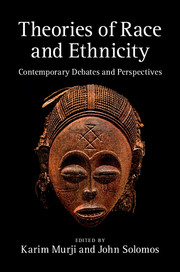Book contents
- Frontmatter
- Contents
- Notes on contributors
- Preface
- 1 Introduction: situating the present
- Part I Debates
- Part II Perspectives
- Introduction to Part II
- 8 Superseding race in sociology: the perspective of critical rationalism
- 9 Critical race feminism
- 10 Performativity and ‘raced’ bodies
- 11 Racism: psychoanalytic and psychosocial approaches
- 12 The sociology of whiteness: beyond good and evil white people
- 13 (Sexual) whiteness and national identity: race, class and sexuality in colour-blind France
- 14 Racial comparisons, relational racisms: some thoughts on method
- 15 Conclusion: back to the future
- Index
Introduction to Part II
Published online by Cambridge University Press: 18 December 2014
- Frontmatter
- Contents
- Notes on contributors
- Preface
- 1 Introduction: situating the present
- Part I Debates
- Part II Perspectives
- Introduction to Part II
- 8 Superseding race in sociology: the perspective of critical rationalism
- 9 Critical race feminism
- 10 Performativity and ‘raced’ bodies
- 11 Racism: psychoanalytic and psychosocial approaches
- 12 The sociology of whiteness: beyond good and evil white people
- 13 (Sexual) whiteness and national identity: race, class and sexuality in colour-blind France
- 14 Racial comparisons, relational racisms: some thoughts on method
- 15 Conclusion: back to the future
- Index
Summary
In the introduction to this volume, we set out the shift from classical sociological and anthropological theories and perspectives on race to the emergence of post-structralist theories concerned with language, identities, bodies, subjectivity and the politics of difference. The latter covers a wide range of approaches to race that challenge the kind of perspectives that featured in the 1986 Rex and Mason volume. In two particular ways, these approaches mark the shift from and challenge the picture set up in the 1980s. First, instead of grand structrual theories, they tend to be more like middle-range theories or perspectives. Second, they move beyond the boundaries of conventional social science disciplines such as sociology and signal the ways in which the field of race and ethnicity studies is now diversified in drawing on a range of traditions and themes. Consequently, in terms of their reach, some of these approaches map various kinds of intersectional theorising that link contemporary forms of race and racism with historical, cultural and literary analyses that are evident in a range of anti-foundational approaches in the social sciences and humanities. The perspectives that we have included in this section range from critical rationalism to critical race feminism, performativity, psychoanalysis/the psychosocial and critical whiteness studies. This section concludes with an analysis of what studying race in a trans-national or globalised environment should entail in terms of method and approach.
Chapter 8, by Michael Banton, is concerned with how the concepts of race and ethnicity have been understood in the social sciences and in everyday language. Banton’s argument is that the concept of race is among those folk concepts – including racism, anti-Semitism, ethnicity, Islamophobia and multiculturalism – that are inadequate for sociological analysis because they are so marked by their political connotations and contexts. Drawing on social exchange and rational choice theories, Banton argues that the perspective of critical rationalism, rather than beginning with ideas and terms such as racism and ethnicity and using them as explanations, instead calls for a focus on developing and testing concepts that account for or explain observable variations in behaviours.
- Type
- Chapter
- Information
- Theories of Race and EthnicityContemporary Debates and Perspectives, pp. 140 - 142Publisher: Cambridge University PressPrint publication year: 2014

